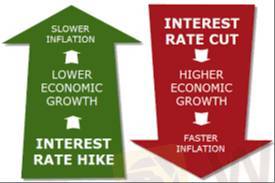
2025-02-18 01:29
IndustriUnderstanding Interest Rate and Forex Markets
firstdealofthenewyearastylz
The relationship between interest rates and foreign exchange (forex) markets is crucial in global finance. Here's how they interact:
1. Interest Rates and Currency Value
Interest rates directly impact currency value because they influence capital flows and investor behavior.
Higher Interest Rates → Stronger Currency
When a country raises interest rates, it attracts foreign investment because investors seek higher returns. This increases demand for the currency, causing appreciation.
Example: If the Federal Reserve raises U.S. interest rates, the USD strengthens as investors buy dollars to invest in U.S. assets.
Lower Interest Rates → Weaker Currency
Lower interest rates reduce the incentive for foreign investors, leading to capital outflows and depreciation of the currency.
Example: If the European Central Bank (ECB) cuts interest rates, the Euro (EUR) may weaken as investors shift to higher-yielding assets elsewhere.
2. Interest Rate Differentials and Carry Trade
Carry Trade Strategy
Traders borrow in a low-interest-rate currency and invest in a higher-interest-rate currency to profit from the rate differential.
Example: Borrowing Japanese Yen (JPY) (low rate) and investing in Australian Dollar (AUD) (higher rate).
If a central bank changes interest rates unexpectedly, it can disrupt carry trades and cause volatility.
3. Central Bank Policies and Market Reactions
Hawkish Policy (Rate Hike or Tighter Monetary Policy) → Currency Strengthens
Dovish Policy (Rate Cut or Loose Monetary Policy) → Currency Weakens
Forward Guidance (Central banks signaling future rate changes) can also move forex markets before actual rate changes.
4. Inflation, Interest Rates, and Forex
High inflation often leads to higher interest rates (to control inflation), strengthening the currency.
If inflation erodes purchasing power faster than interest rate hikes, the currency may still weaken.
5. Global Risk Sentiment & Safe-Haven Currencies
In times of economic uncertainty, investors move toward safe-haven currencies like the USD, CHF (Swiss Franc), or JPY regardless of interest rate trends.
Bottom Line
Interest rates are one of the most significant drivers of forex markets. Traders watch central banks like the Federal Reserve (Fed), ECB, Bank of Japan (BoJ), and Bank of England (BoE) closely for policy shifts.
Suka 0

Vince024
Pialang
Diskusi populer
Industri
СЕКРЕТ ЖЕНСКОГО ФОРЕКСА
Industri
УКРАИНА СОБИРАЕТСЯ СТАТЬ ЛИДЕРОМ НА РЫНКЕ NFT
Industri
Alasan Investasi Bodong Tumbuh Subur di Indonesia
Industri
Forex Eropa EURUSD 29 Maret: Berusaha Naik dari Terendah 4 Bulan
Analisis pasar
Bursa Asia Kebakaran, Eh... IHSG Ikut-ikutan
Analisis pasar
Kinerja BUMN Karya Disinggung Dahlan Iskan, Sahamnya Pada Rontok
Klasifikasi pasar

Platform

Pameran

Agen

Perekrutan

EA

Industri

Pasar

Indeks
Understanding Interest Rate and Forex Markets
 Hong Kong | 2025-02-18 01:29
Hong Kong | 2025-02-18 01:29firstdealofthenewyearastylz
The relationship between interest rates and foreign exchange (forex) markets is crucial in global finance. Here's how they interact:
1. Interest Rates and Currency Value
Interest rates directly impact currency value because they influence capital flows and investor behavior.
Higher Interest Rates → Stronger Currency
When a country raises interest rates, it attracts foreign investment because investors seek higher returns. This increases demand for the currency, causing appreciation.
Example: If the Federal Reserve raises U.S. interest rates, the USD strengthens as investors buy dollars to invest in U.S. assets.
Lower Interest Rates → Weaker Currency
Lower interest rates reduce the incentive for foreign investors, leading to capital outflows and depreciation of the currency.
Example: If the European Central Bank (ECB) cuts interest rates, the Euro (EUR) may weaken as investors shift to higher-yielding assets elsewhere.
2. Interest Rate Differentials and Carry Trade
Carry Trade Strategy
Traders borrow in a low-interest-rate currency and invest in a higher-interest-rate currency to profit from the rate differential.
Example: Borrowing Japanese Yen (JPY) (low rate) and investing in Australian Dollar (AUD) (higher rate).
If a central bank changes interest rates unexpectedly, it can disrupt carry trades and cause volatility.
3. Central Bank Policies and Market Reactions
Hawkish Policy (Rate Hike or Tighter Monetary Policy) → Currency Strengthens
Dovish Policy (Rate Cut or Loose Monetary Policy) → Currency Weakens
Forward Guidance (Central banks signaling future rate changes) can also move forex markets before actual rate changes.
4. Inflation, Interest Rates, and Forex
High inflation often leads to higher interest rates (to control inflation), strengthening the currency.
If inflation erodes purchasing power faster than interest rate hikes, the currency may still weaken.
5. Global Risk Sentiment & Safe-Haven Currencies
In times of economic uncertainty, investors move toward safe-haven currencies like the USD, CHF (Swiss Franc), or JPY regardless of interest rate trends.
Bottom Line
Interest rates are one of the most significant drivers of forex markets. Traders watch central banks like the Federal Reserve (Fed), ECB, Bank of Japan (BoJ), and Bank of England (BoE) closely for policy shifts.
Suka 0
Saya juga ingin komentar
Tanyakan pertanyaan
0Komentar

Belum ada yang berkomentar, segera jadi yang pertama

Tanyakan pertanyaan
Belum ada yang berkomentar, segera jadi yang pertama